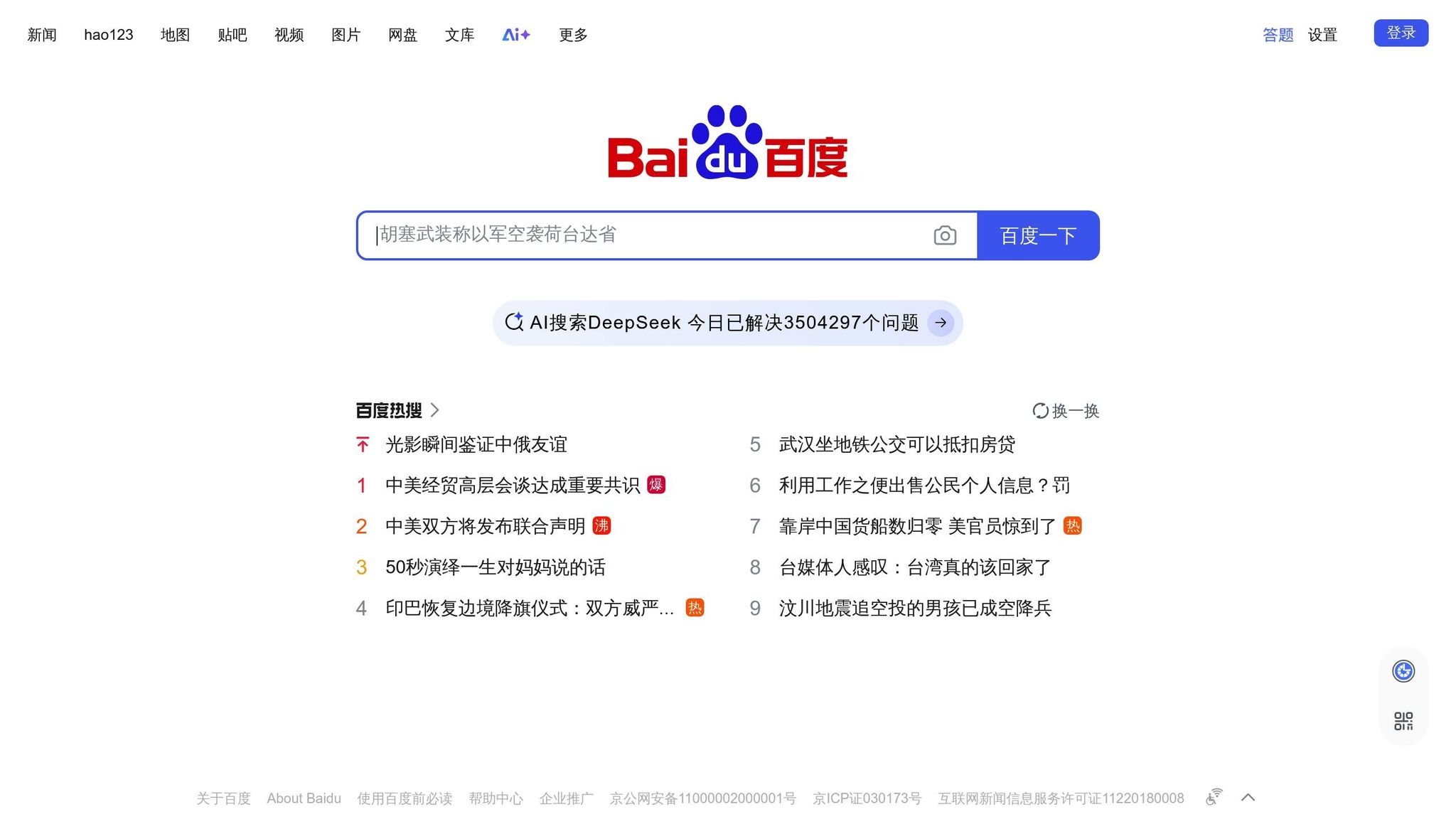Localized search algorithms focus on delivering results tailored to a user’s location, language, and behavior. Here’s what you need to know:
- Why it matters: Search engines like Google and Baidu prioritize location-specific results to meet user needs. For example, "football" in the U.S. means American football, while in the U.K., it refers to soccer.
- Key strategies for businesses:
- Local content: Use local keywords, dialects, and culturally relevant content.
- Technical SEO: Optimize for mobile, use hreflang tags, and ensure fast loading speeds.
- Compliance: Follow regional data laws like GDPR (EU), CLOUD Act (U.S.), or China’s Cybersecurity Law.
- Behavioral insights: Adapt to local search patterns, click-through rates, and user preferences.
- Search engine methods: Google uses IP geolocation, language detection, and user behavior analysis. Baidu focuses on mobile-first indexing and regional compliance.
Quick Summary Table:
| Factor | Baidu | |
|---|---|---|
| Location Signals | IP geolocation, GPS, user behavior | Geolocation system, maps integration |
| Mobile Optimization | Mobile-first indexing, fast loading | Mobile Instant Pages (MIP) |
| Compliance | GDPR, CLOUD Act | ICP license, data localization |
| Content Localization | hreflang tags, regional keywords | Regional dialect recognition |
To succeed, focus on technical precision, local content, and compliance. These strategies ensure your business stays visible and relevant in regional searches.
Google E A T Algorithm Local Search Engine Optimization Tutorial
How Search Engines Localize Results
Search engines use a blend of location data, language understanding, and contextual cues to tailor results specifically to a user’s region. These systems are now so advanced they can differentiate between neighborhoods within the same city, creating a highly targeted search experience. Here’s a closer look at how they do it.
Key Location Signals
Search engines pinpoint user locations using various methods, including:
- IP address tracking to identify geographic areas
- GPS data from mobile devices
- Browser location settings
- Wi-Fi and cellular triangulation
- Historical search patterns
These techniques have significantly improved over time. For instance, between March 14–16, 2025, advancements in geotargeting led to more precise results for mobile searches.
Understanding Language and Context
Modern search algorithms also analyze how people in different regions use language. This includes recognizing:
| Feature | How It Works | Why It Matters |
|---|---|---|
| Dialectal Differences | Identifies regional terms (e.g., "apartment" vs. "flat") | Delivers results that feel more locally relevant |
| Colloquialisms | Machine learning models trained on local data | Understands and interprets regional slang accurately |
| Implicit Location | Identifies location references in queries | Provides context-specific results without extra input |
For example, if someone searches for "DMV hours", the search engine can interpret whether the user means the Department of Motor Vehicles in California or the DC–Maryland–Virginia area, even without explicit location terms.
Mobile-First Regional Indexing
Mobile devices play a huge role in shaping local search results. Search engines prioritize:
- Websites that are mobile-friendly and load quickly
- A seamless mobile user experience
- Hyperlocal targeting, which uses precise location data
- Patterns of app usage that indicate regional preferences
This hyperlocal approach ensures that search engines not only deliver accurate results but also consider how users engage with local content on their devices.
Behavioral Signals and Local Relevance
User behavior is another key factor in refining localized search results. Updates rolled out between March 20–22, 2025, improved the way algorithms evaluate:
- Click-through rates from users in specific regions
- Dwell time and bounce rates on local pages
- Query refinements that show a clear local intent
- Physical visits, as tracked via mobile devices
These behavioral insights help search engines adapt and stay relevant, ensuring the results align with the user’s location, timing, and preferences. By continuously fine-tuning these strategies, search engines aim to deliver results that feel as personalized as possible.
Meeting Regional Search Requirements
Search engines don’t just deliver results – they also have to navigate a maze of regional rules and regulations. Balancing relevant search results with legal compliance is no small feat. Three major frameworks shape these regional requirements: the EU’s GDPR, the US CLOUD Act, and China’s Cybersecurity Law.
Data Protection and Privacy Requirements
Each region has its own set of rules for handling user data, which significantly impacts how search engines operate:
| Region | Key Requirements | Impact on Search |
|---|---|---|
| European Union | GDPR compliance, explicit consent, right to be forgotten | Anonymized data collection and mandatory opt-in mechanisms |
| United States | CLOUD Act compliance, data access for authorities | Cross-border data management and enhanced transparency |
| China | Data localization, content filtering, real-name verification | Strict content controls and local server requirements |
Compliance Implementation
A March 2025 update underscored the importance of compliance, revealing that non-compliance could negatively affect search rankings. To address these challenges, search engines rely on several technical measures:
- Regional data centers to meet localization laws
- User-friendly consent tools
- Advanced content filtering systems
- Region-specific privacy settings
Financial and Business Impact
Failing to meet compliance standards can be costly. Under GDPR, fines can hit €20 million or 4% of global revenue, whichever is higher. Beyond monetary penalties, non-compliance can harm business in other ways:
- Fewer clicks due to reduced visibility
- Erosion of user trust
- Limited access to certain markets
- Lower rankings in search results
Cultural Considerations
Search engines also consider cultural norms when implementing compliance strategies. For example, in the U.S., there’s a strong focus on transparency, giving users control over their personal data and providing clear options to opt out. These adjustments help ensure that compliance measures align with local expectations.
Technical Implementation Guidelines
To meet regional compliance standards effectively, businesses should:
- Regularly audit their compliance practices
- Develop privacy policies tailored to specific regions
- Strengthen data protection protocols
- Continuously monitor how compliance affects search performance
These steps highlight how search engines and businesses adapt to meet local regulations while still delivering meaningful and relevant search experiences.
1. Google’s Regional Search Methods
Google has developed a sophisticated approach to regional search, leveraging algorithms that analyze user location, language preferences, and search behavior. This enables the search engine to provide results tailored to local needs. While many search engines employ localization strategies, Google’s methods often set the standard for precision in regional optimization. This targeted approach aligns seamlessly with broader regional strategies.
Core Components of Google’s Local Search
Google’s regional search relies on three key elements:
| Component | Function | Impact |
|---|---|---|
| IP Geolocation | Identifies the user’s location | Helps Google fine-tune local search rankings for better relevance |
| Language Detection | Determines preferred language | Ensures content matches user preferences and ranks accordingly |
| User Behavior | Analyzes search patterns | Personalizes search results based on user habits and intent |
Technical Implementation Requirements
To optimize for Google’s regional search, businesses should focus on these technical aspects:
- Location Signals: Keep NAP (Name, Address, Phone Number) information consistent across platforms and use proper schema markup to enhance local search visibility.
- Language Optimization: Use hreflang tags to indicate language and regional targeting, and implement region-specific URLs for better alignment with user preferences.
- Mobile Responsiveness: Ensure websites are mobile-friendly with fast loading times and layouts that adapt seamlessly to smaller screens.
These measures not only improve user experience but also boost search performance.
Recent Performance Metrics
The benefits of effective regional optimization are clear. For instance:
"Search X has been a game-changer for our SEO, significantly boosting our online visibility and rankings. I highly recommend them for their effective results and professional service!" – Lucas Garcia
This feedback highlights the tangible results businesses can achieve when they meet Google’s technical requirements for regional search.
Compliance and Regional Variations
Google’s regional search strategies also take into account jurisdictional differences, particularly in areas like data privacy and content restrictions. For example, in the United States, businesses must comply with state-specific privacy laws while maintaining their local search presence.
Key factors prioritized by Google’s regional algorithms include:
- Displaying business operating hours in the correct time zone
- Understanding and addressing area-specific search intent signals
These considerations ensure that Google’s regional search results remain relevant and compliant, no matter the location.
sbb-itb-880d5b6
2. Baidu‘s Local Search Systems

Baidu’s local search system is designed to address the unique needs of China’s diverse regions. This focus is evident in its technical framework and strict regulatory standards, as outlined below.
Core Technical Framework
Baidu’s local search success hinges on several critical components:
| Component | Function | Performance Metrics |
|---|---|---|
| Geolocation System | Targets specific provinces and cities | 70% of local searches result in store visits within 24 hours |
| Mobile Integration | Delivers location-based results on mobile | 80% of above-the-fold mobile content is location-specific |
| Business Verification | Builds trust with verified businesses | Verified businesses see a 40% boost in visibility |
| Maps Integration | Simplifies business discovery | 700 million monthly active users utilize Baidu Maps |
Technical Requirements for Optimization
To make the most of Baidu’s platform, businesses need to meet specific technical criteria:
- Server Configuration
Ensure websites use UTF-8 encoding for proper indexing. Hosting on servers located in China is essential for faster response times, as Baidu’s crawler is less forgiving of slow-loading pages compared to other search engines. - Mobile-First Architecture
With over 90% of Baidu searches happening on mobile devices, adopting the MIP (Mobile Instant Pages) framework is crucial. Optimize for voice search and include clear, actionable call-to-actions to improve engagement. - Local Entity Validation
Baidu verifies local businesses across its ecosystem. Verified businesses benefit significantly, with data showing up to a 40% increase in search visibility.
Regulatory Compliance Framework
Baidu operates within a regulatory environment that differs greatly from Western systems. Businesses must adhere to the following rules:
- Obtain an ICP (Internet Content Provider) license
- Store all data within mainland China
- Conduct regular content audits to ensure compliance
- Follow industry-specific regulations closely
Regional Dialect Recognition
Baidu’s advanced language processing capabilities allow it to understand regional dialects like Cantonese in Guangdong and Shanghainese in Shanghai. This system enhances local search by incorporating:
- Analysis of regional consumer preferences
- Recognition of local landmarks
- Integration of cultural references
- Insights into shopping behavior patterns
3. SearchX‘s Local Search Solutions

SearchX offers a specialized approach to improving local search performance through a region-focused framework. By combining local expertise with technical precision, they tackle the unique challenges businesses face in localized search environments.
Regional Optimization Framework
At the heart of SearchX’s local search strategy are several key components designed to strengthen a business’s presence in specific regions:
| Component | Implementation | Impact |
|---|---|---|
| Local Content Strategy | Developing region-specific keywords and tailored content | Increases visibility in local searches |
| Technical SEO | Enhancing server response times and prioritizing mobile-first indexing | Boosts search rankings |
| Business Profile Management | Optimizing and verifying local business profiles (e.g., Google Business) | Improves customer engagement |
| Regional Compliance | Adhering to location-specific regulations and SEO best practices | Meets local requirements effectively |
Performance Tracking System
SearchX employs a real-time dashboard that keeps tabs on key metrics like search visibility, user engagement, and performance in specific regions. This system ensures that local SEO strategies remain aligned with current standards and trends.
Technical Implementation
To optimize for mobile users, SearchX focuses on accelerated page loading and responsive design. Additionally, they utilize local schema markup to provide search engines with clear, structured business information, boosting search accuracy and relevance.
Success Metrics
The effectiveness of SearchX’s local strategies is evident in their results. For instance, they have achieved an average Google rating of 4.95 from 45 reviews, underscoring their clients’ satisfaction and the impact of their methods.
Regulatory Compliance
SearchX prioritizes compliance by conducting regular audits, verifying business information, and implementing schema markup. They also stay ahead of evolving local regulations, ensuring businesses remain up-to-date and compliant. These efforts form a solid foundation for tackling regional search optimization challenges effectively.
Strengths and Limitations
Continuing our dive into regional search methods, let’s explore the upsides and hurdles of localized optimization. For businesses aiming to strengthen their regional footprint, the landscape offers both opportunities and challenges.
Core Strengths
Regional search algorithms have come a long way, providing businesses with tools to sharpen their local strategies:
| Strength | Impact | Implementation Requirements |
|---|---|---|
| Precision Targeting | Greater local visibility | Accurate local data and business details |
| Mobile Optimization | Better user experience | Responsive design and fast loading times |
| Local Intent Matching | Higher conversion rates | Region-specific keyword optimization |
| Compliance Management | Fewer legal risks | Regular audits and updates |
One standout feature is the focus on real-time tracking and compliance monitoring, which has proven especially useful for companies operating in multiple regions.
Technical Constraints
Despite its advantages, local search optimization comes with its own set of challenges:
- Frequent Algorithm Updates Regional search algorithms are constantly evolving, requiring businesses to stay on their toes and adjust strategies regularly.
- Resource Demands Managing region-specific content and technical setups can be resource-intensive. However, businesses often see significant growth when they invest in skilled teams.
- Compliance Complexity Different regions have unique regulations and standards, making it tricky to meet all requirements simultaneously.
These challenges highlight the importance of staying proactive, as detailed in strategies for maintaining long-term success.
Performance Considerations
Several factors influence the balance between technical execution and local audience engagement:
| Factor | Impact Level | Optimization Challenge |
|---|---|---|
| Server Location | High | Regional hosting requirements |
| Content Relevance | Critical | Adapting language and local context |
| Technical Setup | Moderate | Proper technical configurations |
| User Behavior | Variable | Understanding regional search habits |
SearchX tackles these challenges with tailored SEO strategies, focusing on results rather than just deliverables. Their use of real-time dashboards and regular updates ensures businesses can effectively monitor and refine their regional search efforts.
Future-Proofing Strategies
To maintain success in local search optimization over time, businesses should prioritize:
- Adaptive Technologies: Use flexible systems that can handle frequent algorithm changes.
- Scalable Solutions: Build strategies that grow alongside business expansion.
- Compliance Frameworks: Create systems to navigate diverse regional regulations.
"We don’t just promise clicks; we deliver qualified buyers to your site, turning traffic into revenue."
Conclusion
The shifting dynamics of search algorithms require businesses to blend technical expertise, local relevance, and adaptability to stay competitive. As regional algorithms continue to evolve, companies must prioritize robust technical setups, localized content strategies, and ongoing monitoring to ensure visibility and compliance in their target markets. Let’s break down the three key pillars for success:
- Technical Implementation
A solid technical foundation is non-negotiable. This includes optimizing server configurations, ensuring mobile-friendly designs, and conducting regular technical audits. These steps help maintain top-notch performance across different regions.
- Content Localization
Creating content that resonates with local audiences is essential. This means aligning content with local customs, regulations, and user behaviors to build trust and engagement. Here’s how it breaks down:
| Aspect | Focus Area | Benefit |
|---|---|---|
| Local Customs | Adapting to cultural norms | Boosts user engagement |
| Legal Compliance | Meeting regional regulations | Reduces legal risks |
| User Behavior | Addressing specific needs | Increases conversion rates |
Localized content works hand-in-hand with technical efforts to strengthen connections with local audiences.
- Monitoring and Adaptation
Staying ahead means keeping a close eye on market trends and algorithm updates. Regular monitoring allows businesses to tweak strategies quickly, ensuring steady visibility and relevance in dynamic markets.
The key to thriving in regional search optimization lies in balancing a global presence with local precision. By focusing on these core elements and staying adaptable, businesses can lay the groundwork for sustained growth in their target regions.
With SearchX’s customized solutions and data-driven results, businesses can achieve both technical excellence and local relevance, paving the way for long-term success.
FAQs
How do search engines like Google and Baidu use geolocation to provide region-specific search results?
Search engines like Google and Baidu rely on geolocation data to customize search results based on where users are physically located. They analyze details like IP addresses, GPS information, and device settings to pinpoint a user’s location and provide results tailored to their area.
For instance, if someone searches for "coffee shops" in New York, they’ll see a list of nearby cafes in the city. Meanwhile, a person in Los Angeles making the same search will get completely different recommendations. This approach creates a more personalized and practical experience, making it easier for businesses to connect with their local audience. To maintain visibility in these localized searches, businesses should prioritize optimizing their Google Business Profile, incorporate location-specific keywords, and ensure their address and contact details are consistent across all platforms.
What challenges do businesses face when optimizing for regional search engines, and how can they overcome them?
Businesses often face hurdles when trying to optimize for regional search engines. These challenges stem from differences in algorithms, local preferences, and legal requirements. For instance, keyword usage, the relevance of local content, and compliance with region-specific data privacy laws can vary widely across regions.
To overcome these obstacles, start with local keyword research to ensure your content matches the language and search intent of your target audience. Crafting content that aligns with regional cultural and linguistic nuances is equally important. Additionally, staying informed about local regulations, such as GDPR in Europe or CCPA in California, is crucial to avoid legal issues and penalties.
If you’re looking to fine-tune your regional SEO strategy, consider using specialized tools or consulting experts who understand the nuances of localized search engine updates.
How can businesses adjust their SEO strategies to reflect regional language and cultural differences?
To make your SEO strategy resonate with regional audiences, it’s crucial to dive into the nuances of local language, preferences, and search habits. Start by focusing on region-specific keywords – don’t overlook dialects, slang, or spelling differences. For instance, while Americans say "apartment", the same might be called a "flat" elsewhere.
Beyond keywords, shape your content to reflect local customs and values. This could mean incorporating references to regional holidays, events, or popular trends that your audience relates to. Also, ensure your website is ready for local search by keeping your NAP (Name, Address, Phone) details accurate and consistent. Creating landing pages tailored to specific locations can further boost your visibility in regional searches.
If this feels overwhelming, teaming up with an SEO agency like SearchX can simplify the process. They specialize in building localized strategies that help businesses connect with regional audiences and climb the search rankings.




